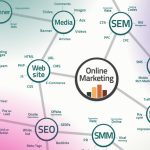Last Updated on 16th February 2024
Video Marketing Rises
Video marketing is a must-have element in any modern marketeers toolkit.
There can be little doubt that video marketing is destined to be the most effective form of advertising. TV has been for over half a century. All we are doing now is moving the medium online where it is accessible for all businesses and not exclusive to multi-million dollar corporations.
YouTube has been the driver of online video, but is now challenged with the emergence of video facilities on social media networks, in particularly Facebook and Twitter’s Vine.
With the emergence of advanced internet technology capable of supporting large media files without slowing down upload speeds, online video campaigns have the platform to make an impact – providing your video content is effective that is.
The number of internet users digesting video content is growing, and with platforms hosting digital video adverts, brands have the possibility of reaching a wider target audience.
YouTube has been a mainstay of video advertising and now it has been joined by Facebook, there has never been a better time to advertise online using a video format.
Video is easy to digest and with more mobile users engaging with online content, video is the preferred choice of format. Nielson reports that 64% of marketers say video marketing will dominate their digital marketing strategy by 2017.
It is estimated that around 20 million people watch at least one online video a week in the UK alone, and it is young mother’s that are engaging with video content more than any other audience type.
Last year, there was a 75% global increase in video ads on Facebook and 70 million videos posted a day on Instagram. Google says that video accounts for two-thirds of traffic.
Video is arguably the most consumed content on the net. Social networks such as YouTube with 5bn viewers a day, Facebook (3bn) and Snapchat (a whopping 10bn) are the busiest platforms. And with the emergence of new technologies, video gives brands the opportunity to deliver a fully immersive experience.
Since 2012, the growth of video content has been explosive. Given most online users are accessing the web on mobile phones, together with a reduction in concentration levels, it’s hardly surprising that video is the most popular online media.
Video Marketing and Virtual Reality
And video content is beginning to move far beyond standard promotional ads. The introduction of Virtual Reality headsets (VR), Augmented Reality (AR), 360 video and 3D software, brands have the ability to replicate real-life in the online space.
Video Shopping Experiences
This means online businesses can reproduce shopping experiences that are akin to your bricks-and-mortar store. VR headsets block out physical senses to the outer world whereby the brain thinks what viewers are seeing in screen is real. This enables brands to recreate a sensory experience online that includes, sight, smell and sound.
With competition in the online sphere at a premium, today’s business owners have to look for alternative and creative ways of engaging customers. Standard video promotions have a reasonably impressive success rate – but the latests technologies have the potential to perform even better.
Video has made a major impact in the digital marketing arena over the last few years. Motion pictures are easily digested and according to statistics already accounts for 50% of mobile traffic.
Consumers use their mobile phones more than any other device, and because video is the preferred format for small screen users, advertisers simply cannot ignore video marketing.
Furthermore, there are more opportunities to publish content on video platforms and reach a wider, targeted audience. A crop of innovative companies have emerged in the last few years that help online businesses extend their reach to a wider audience.
Scott Knoll, CEO of Integral Ad Science, predicts that we will, “see more integrated ad measurement in 2016, leading to cross-platform measurement becoming the standard for campaigns.”
Increased opportunities for video advertising
The number of young people choosing online video over traditional TV is on the rise. According to reports 62% of young people prefer YouTube to traditional TV.
Together with the emergence of on-demand online streaming through the likes of NetFlix and Amazon Prime, the younger generations are ditching TV packages in favour of online sources.
The growing number of platforms that are emerging to host video content is therefore growing at an exponential rate.
This gives advertisers more opportunities to air video content across multiple-channels and reach a wider audience, and because of the increased competition, costs are more affordable than in the past.
Online advertisers also have to rethink their online marketing strategy. An increasing number of intrusive, misplaced and irrelevant ads are beginning to take its toll on consumers. And they are running out of patience. Spam filter and ad block software is becoming more prevalent and this is just the tip of the iceberg.
As the already limited space of on-screen landscape gets narrower, in-stream videos offer marketers a platform that is not easily avoided and is a more effective medium.
Recorded video and live streaming
There are two methods of producing video ads; recorded video and live streaming.
Pre-recorded videos can be aired as standalone ads on your website, social media networks and in-stream videos.
To date, recorded videos are the industry standard and enable advertisers to plan the marketing message, tell a story and give you less room for error.
In 2015, live streaming took the public imagination by storm. Top brands such as Adidas, 7UP and Doritos took advantage of staged events to get access to real people in real time.
These ads became an instant success. It’s reality TV in ad form. Viewers love the unpredictability and take an avid interest in real people rather than celebrities.
With social media apps Meerkat and Periscope attracting some 12 million users and counting, live streaming is destined to become ‘the next big thing’ in advertising.
Online consumers still trust word of mouth over any other form of advertising. And live streaming in real-time presents brands with the opportunity to get a genuine reaction from real people!
The number of consumers that prefer to watch video over any other form of advertising will continue to grow. If video is not already part of your marketing campaign, make it a priority inclusion or you could be missing out.
The potential of virtual reality videos
There has been a lot of media hype around virtual reality goggles for several years now. Until last year when Oculus nailed the Rift, and a spate of top tech companies followed suit with their version of VR goggles, hardware had been a disappointed.
VR as a technology may still be in its infancy, but customers are already beginning to show a real interest. In a recent survey published by GfK, 36% of respondents confirmed VR could impact their purchasing decisions. Experts predict the VR industry will be worth around $5.2bn dollars by the end of next year.
US software development company Sabre Labs say VR can help online businesses in three ways; to provide inspiration, to train staff and as an interactive advertising platform. And because VR is compatible with mobile devices, high-end computers and games consoles, marketers can seamlessly fit VR content anywhere into the purchasing path.
In terms of marketing content, VR presents the opportunity to produce virtual tours, real-life demonstrations, 360 views of your product and 3D simulations that create a fully immersive and interactive experiences
Virtual guided tours
360 video gives your customers the opportunity to inspect products in the virtual space in a similar way they might if they were browsing your shop – other than actually picking up the item and testing it.
Considering many products are in packages, 360 video enables some stores to provide more information to your customers. If you also produce a demonstration video, buyers have far better knowledge of what they can expect from their purchase. Traditional shopping can’t often offer these kind of insights.
Furthermore, marketers can incorporate galleries into VR footage and create a 360 virtual reality tour. The Marriott Hotel chain shows you can use video technology online and offline. They use 360 video to showcase their rooms and also have VR technology available to guests revealing the city highlights visitors might want to experience for themselves.
Video and 360 is also now increasingly utilised by brands looking to provide a fly-on-the-wall view of the interior of their business premises, stores and showrooms.
3D Simulations
3D simulations have moved on from the graphic designs of animated cartoons. VR headsets reconstruct an environment and artificially stimulates the sensory perceptions in a 3D world that replicates the real world.
As a result, users physically believes they are experiencing what they are seeing, hearing and smelling. A good example, can be found on the Google Earth app for the HTV Vive headset. With the ability to transport customers anywhere in the world, cutting-edge technology can offer online consumers an accurate expectation of products and services before they buy.
Interactive VR experiences
Marketers should look to take video promotions one step further by providing viewers with an interactive experience. Interactive VR has the potential to be the most powerful marketing tool tin history. What could have more of an impact than inviting customers into your business and demonstrating how to use your products?
Interactive features in video content also engage users – a major boost for your SEO ratings. And companies that take advantage of immersive marketing channels to reach a wider audience have more power to raise product awareness and build your brand across multiple platforms.
A good example of interactive video promotions is the United Airlines ad that takes advantage of the Oculus Rift headset to showcase its new business class. The beauty of this promotion however was that the airline was able to advertise the new service before it was officially launched.
Augmented Reality
Retailers and fashion designers should be jumping all over augmented reality. The technology allows customers to put themselves or belongings in an on-screen image. This technology will revolutionise online clothes shopping but can be used in other industries as well.
Marketers looking for new and creative ways to create compelling content are pushing the boundaries. As a result, augmented reality has been used to great effect to promote products in the automobile trade, postal service, chewing gum, snack foods and many others.
Video technology is limitless and because VR makes the images so lifelike, ads have the potential to reveal what customers are paying for before they buy. Brands can therefore expect VR video promotions to make a significant impact on consumer purchasing decisions.
And because VR technology has such huge potential, early adopters can expect to see a significant increase in sales revenue. The possibilities for promoting products and services are boundless and because the technology is user-friendly across multiple devices, implementing and using VR is straightforward.
Tools To Help You Create & Market Video Content
As the web becomes a more visual place for everyone, video content is the premium option for engaging your audience quickly and more effectively. The trouble with video content is it sends shivers down the spines of businesses owners on a tight budget.
The goal for marketers is to determine how to best utilise video tools in order to create engaging ads in motion picture.
The general consensus is that video doesn’t come cheap and unless you happen to have a camera crew, sound team and production staff, the concept of video content might seem out of reach. This doesn’t have to be the case though, as there are video options for every budget and we’re starting right at the bottom today with these free online tools to help you break into video content.
PowToon
Powtoon is a free tool that allows you to create animated videos and presentations. The great thing about animations is you don’t need a film crew, sound team or actors – you just need the animators and PowToon gives everyone the chance. So if you really don’t have the budget for video content, start here and invest in a professional animator further down the line.
Wideo
Wideo is a slightly more advanced approach to animated videos that comes with a bunch of paid packages. There’s also a free option that allows you to create 45s clips and keep 10 tracks in your sountrack library, plus 380 images. The most expensive plan gives you 15 minutes with 50 tracks and 1300 images for $49 a month or $399 per year. But there is no reason you can’t start with the free option – ideal for social videos and apps like Vine.
Superflix
Superflix gives you a free platform for creating live action videos. Simply record your footage or take your snaps and upload them to Superflix to edit them into a final clip. Small businesses don’t need to worry about cutting edge filming equipment and star names – just a concept that will capture your audience and the right tools to help you bring it all together. Superflix makes this affordable with a free option and PRO sign up for $25 a month if you buy a year’s subscription.
Screenr
Screenr is a free screencast application that lets you record exactly what is happening on your monitor screen. This will prove more useful to some businesses than others, but let’s say you run an IT business, for the sake of example. With Screenr you can record solutions to common problems your customers face, “how to” videos and a range of tutorial videos for Mac or PC.
Wistia
Wistia is a video hosting and analytics tool designed with content marketing in mind. You can sign up to free or paid options that come with increasingly advanced features – including customised media players, engagement graphs and collaboration tools. You can sign up for a free account or the Small Business plan for $25 a month and a Team account for $100 per month.Get out there and create
With this range of free tools available there is no excuse for website owners to ignore video content. The cost fears are less relevant now than ever and your only obstacle is enough creativity to put these tools to use.
YouTube is the largest video hosting site on the net and with one billion unique visitors a month, getting your marketing video wrong is not an option.
The popularity of the platform is because it is free to register and account and post motion pictures. But there is also a comments field for users to leave comments. And YouTube users do not mix their words. Don’t all them to throw daggers.
Furthermore, the high volume of videos posted on a daily basis makes it more difficult for marketing videos to stand out, therefore don’t make these three marketing mistakes with your video marketing strategy.
So What About Video Content?
Your video will ultimately be defined by the nature of its content. The first hurdle you have to get over is attracting eyes to watch it. The second hurdle is for viewers to take action after watching it.
Slick cinematography and good sound quality go a long way to keeping viewers watching, but the most important thing is for the video to contain rich content and that your message is given the time it deserves.
For example, if you have a product that people are passionate about such as cars, viewers are happy to watch a 10-minute detailed explanation of the car, see the interior and how the gadgets work than a 1-minute video of the car in action.
Hi-res images are a must
Smartphone screens and HD televisions have spoiled us. After watching pin sharp and pristine images, anything grainy or low-res is not acceptable. Consumers will judge your video on performance, and if you shoot low-quality resolution videos, it is a reflection that your company produces low quality products.
Include SEO-friendly tags with videos
Remember those one billion annual videos we mentioned earlier? Well, releasing your video on YouTube is like releasing a fish into the ocean. If you want people to see it, they have to be able to find it.
This is where knowledge of SEO keywords and metatags come in. YouTube has a search engine powered by Google, thus is as powerful and works exactly the same way.
Not only do you need a strong headline that includes your master keywords, you also need to include a detailed introductory write up explaining what the video is about.
You do not have to explain what the watcher is likely to expect, but raise enough curiosity so they are enticed into watching. And include as many keyword phrases as possible without making the write-up too long-winded or reading like a list a keywords. It has to make sense and be written for humans.
Finally, don’t forget to include metatags and pop your video in the relevant categories. Building some categorised playlists will add further relevance and help viewers to find what they’re looking for much more easily (and search engines too of course). If you are accustomed to loading up blog posts this should not require any explanation.
If you are not aux fait with blogging platforms, check out a YouTube video about how to enter metatags.
Mums on Youtube
A recent Google think piece highlighted that 83% of mother’s are tuning into YouTube – more than any other audience member.
The survey reveals that mother’s will typically watch five videos a day, projecting a 70 per cent increase in opportunities for brands to target mother’s with young families.
But it is the type of content mother’s tune into that is specifically different than other types of viewers. Music related videos, people blogs and light entertainment are the preferred choices.
The implication for brands is that mothers watch a broader range of videos than the average viewer and are more likely to watch adverts targeting family-orientated content, together with household products, animals and “How To” information.
Even if your product does not specifically target mothers, creating promotional videos that capture a mother’s emotional state in relation to her family gives viewers a strong sense of recognition.
Remember, with video, viewers watch and absorb a scenario rather than focus on a project. Therefore by creating a video which the viewer can associate with, gives your ad a stronger purpose.
Digital advertising is gearing towards video marketing more than ever now that younger generations are more tuned in to digital platforms such as YouTube as opposed to traditional TV’s.
Television adverts dominated advertising for many years and although digital marketing has stolen the thunder, video platforms are likely to help advertising in motion picture reclaim their dominance as the leading advertising tool.
Understanding how categories of viewers spend their time in digital forums give brands an edge when deciding what content will most appeal to viewers.
And with the wealth of consumer behaviour reports available by leading companies like Google, marketers are given a clear insight as o the type of content to create for a target audience.
Facebook Video Versus YouTube
According to social media analytics group SocialBakers, the number of people watching videos on Facebook exceeds the number of viewers received by YouTube.
Two months ago the company discovered that more videos were being uploaded directly to Facebook rather than users posting videos from YouTube. As a result, the social media giant has attracted a large portion of YouTube’s audience.
The study was conducted by assessing the video upload activity of 20,000 brands, media outlets, celebrities and entertainment companies that have a Facebook account.
It was determined that the majority were choosing Facebook over YouTube to post videos. Over the same period, the video share of YouTube has noticeably plummeted.
Marketing success for Facebook
The result is a major success for Facebook, particularly given the network has been criticised by marketers for restricting content and using click-farms which ultimately destroy interaction with real followers.
However, as a file sharing platform, Facebook is the most popular interface on the net and still has a place for marketers. For the top brands at least. But like so many Facebook statistics, SocialBaker’s results are flawed.
Facebook run an autoplay feature that plays videos automatically. The statistics therefore show the number of videos that have been played – and not the number of videos users have chosen to play.
Even still, that marketers are choosing to ignore YouTube in favour of Facebook, indicates they are getting more joy from the social network and can save time uploading videos directly to Facebook rather than channelling them through YouTube.
There is no doubt that Facebook receives the giant share of engagement from social users, but ignoring other platforms may be a strategy brands will regret in the future.
Vine
Advertising on Vine is arguably one of the hardest challenges creative marketers face. What can you say in 6 seconds? Yet there are five Vine tweets posted a second, which means a lot of marketers are recognising the value in the quick-vid platform.
The reason for the huge interest in Vine may be because a six second video is not all that difficult to make if you have the right ideas. The 15 billion Vine loops played daily probably has something to do with it too.
So if you do need inspiration for your Vine ads, here are five angles you can use to make the creative process easier.
Introduce yourself
There’s not much you can say to sell a product in six seconds, but you can say hello in that time. Your website is your virtual store, your digital shop window. Customers see all that through your website, but they don’t see your team, the faceless sales staff. Put yourself in the picture and your audience get a better image of you, your company and your brand.
Demonstrate your product
If you can do something with your product in six seconds, do it. Show your audience what your product is and the results it will give you. If it takes more than six seconds, speed up the footage so the results are akin to a Benny Hill sketch minus the scantily glad models…although…
Get your customers to post vines
Even better than demonstrating products yourself, get your customers to do it. This obviously works better for B2B customers who want to promote their services, but by doing so can promote yours, so be on the look-out for opportunities, and if you have an idea, there is no harm in suggesting content ideas to online businesses that actively produce content.
Create intrigue
Humans are curious by nature. We cannot let things go without knowing what happens next. Don’t you just hate it when the adverts cut in on dramatic cliff hangers? Generate enough intrigue and viewers will follow the white rabbit.
Make a series
An extension of the idea above is to make a series. Coming back to the point about cliff hangers, have you noticed how people talk about soap operas more when the storyline is stretched out and takes another twist. Vine is a great platform for story-telling and with just one idea, you have weeks or even months of content.
Marketing is about evoking emotion in your audience, and by deciding what reaction you want from your audience, helps you focus your ideas into a six-second package.
B2B lead generation with video
Video content enables marketers off all types of businesses to make their brand and products more alive and real in the minds of their audience. What you must remember is that video is a step in the journey of the purchasing path, but one that creates a big impact.
Video content has fast become the king of online lead generation and new research from Software Advice highlights the benefits for B2B marketing. Not only is video the most widely used form of content in the sector, but it’s widely cited as the best way to generate a high volume of quality leads.
This won’t come as a surprise to many marketers who have seen the impact of video content on their clients’ conversion rates. But the study by Software Advice puts the prowess of video in numbers – which will reinforce the importance of video content for business owners.
Video content in numbers
In the study 92% of marketers confirmed they use video as the main driving force of their B2B content strategies. And video was the favourite choice for producing high volumes of quality leads that turn into closed sales.
However, not all video performs the same and live demos of products have been singled out as producing the highest-quality leads for B2B. Of marketers questioned, 45% cited live demos as “excellent” and 42% as “good” for generating leads that result in sales. While viewers are found to respond better when they get more information, rather than your typical sales pitch.
Why people respond to video
When volume of information is the key to generating leads video has a huge advantage over other forms of content. It’s said a picture paints a thousand words so if you apply that theory to moving footage – and include audio, dialogue and text – you’re looking at a wealth of communication in a very short space.
Which is important because time is vital when it comes to content and the sooner you can engage an audience the more chance you have of keeping them around. The key to video is creating a story that speaks your message effectively and gives viewers the information they’re looking for.
Closing the deal
Let’s take a look at live demos as an example. Prospects viewing a live demo are generally quite far down the conversion process (a key reason they generate so many leads). Which means you simply need to close the deal by answering those last few questions between your audience and the “buy” button.
The great thing about live demos is they are live – which gives you a chance to take questions directly from your viewers. This would normally take a bundle of research to find out what prospects need to know before buying your products – and its still important you do this. But with little more than a social network feed you can take live questions from your audience and answer them in a personal, engaging manner.
It’s no coincidence that trade shows are widely cited as the most effective offline method for generating leads. And live demos are the best way to recreate this personal experience between sales reps and potential customers. Engagement as ever is key and when it comes to B2B (and all forms of content marketing) video is your biggest asset in engaging high-quality leads.











